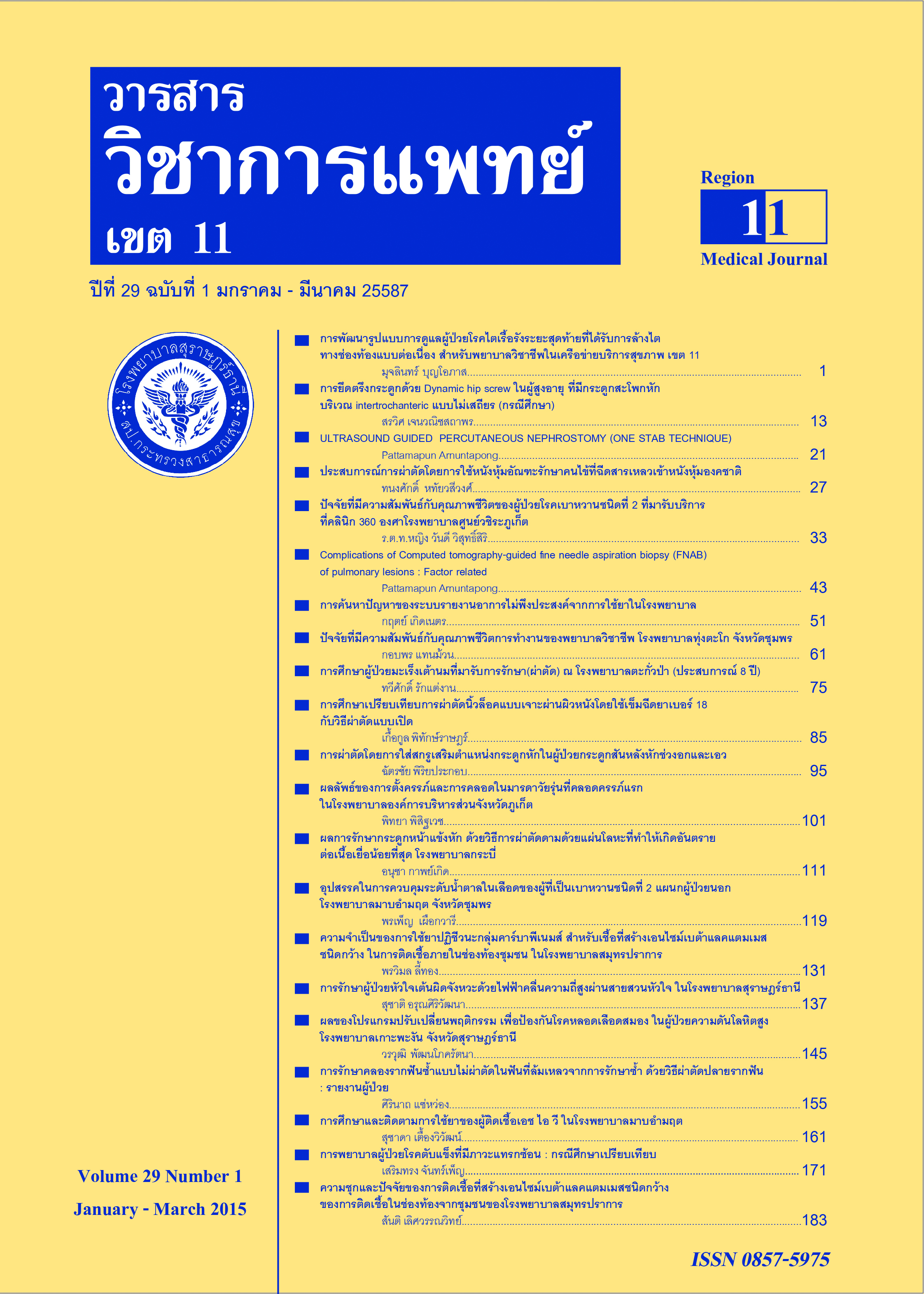Treatment of Radiofrequency Ablation of Cardiac Arrhythmia in Suratthani Hospital
Keywords:
Cardiac arrhythmia, Paroxysmal supraventricular tachycardia, Radiofrequency ablationAbstract
Cardiac arrhythmia is one of the life threatening cardiac problem and also affects quality of life of the patients. Radiofrequency ablation (RFA) has been found to be highly effective and safe in the
treatment of cardiac arrhythmia.Objective : This study is aimed to evaluate the outcome of our first experience of 50 patients who underwent with RFA in Suratthani hospital.Population and methods :The authors retrospectively reviewed between 1 January 2014 to 31 October 2014, there were 50 patients,
whom performed RFA in the electrophysiology laboratory at Suratthani hospital. Type of cardiac arrhythmia, initial success rate and complications were analyzed.Results : Out of 50 patients, the patient age ranged from 21 to 82 years. The mean age was 48 15 years. 70% were female.Duration of symptom before RFA was 1-30 years (Mean 6.3 ± 6.0 year).Cardiac arrhythmia were atrioventricular nodal reentrant tachycardia (AVNRT), atrioventricular reentrant tachycardia (AVRT), atrial
tachycardia, typical atrial flutter and fascicular ventricular tachycardia were found 32, 13, 2, 2, and 1 respectively. Initial success rate was 96%. No serious complication was found. No clinical recurrence was found during 9.1±2.7 months follow-up.Conclusion : Radiofrequency ablation in our institution is safe and highly effective mode of treatment of cardiac arrhythmia with refractory to medical treatment.
References
2. Hoffman BF, Rosen MR. Cellular mechanisms for cardiac arrhythmias. Circ Res 1981;49:1-15.
3. Bathina MN, Mickelsen S, Brooks C, Jaramillo J,Hepton T, Kusumoto FM. Radiofrequency catheter
ablation versus medicaltherapy for initial treatment of supraventricular tachycardia andits impact on quality of life and healthcare costs. Am J Cardiol1998;82:589-93.
4. Morady F. Drug Therapy: Radio-Frequency Ablation as Treatment for Cardiac Arrhythmias. N Engl J Med 1999;340:534-44.
5. Larson MS, McdonaldK, Young C, Sung R, Hlatky MA.Quality of life before and after radiofrequencycatheter
ablation in patients with drug refractoryatrioventricular nodal reentrant tachycardia. Am JCardiol 1999; 84: 471-73.
6. Huang SKS, LEE MA, Razgan ID. Radiofrequency catheter ablation of the atrioventricular junction for
refractory supraventricular tachyarrhythmias.Circulation 1988;78 (Suppl 2):II–156.
7. Lee MA, Mosady F, Kadish A,Schamp DJ, Chin MC,Scheinman MM, et al. Catheter modification of
the atrioventricular junction with radiofrequency energy for control of atrioventricular nodal reentry tachycardia. Circulation. 1991;83:827 – 35.
8. Jackman WM, Beckman KJ, McClelland JH.Treatment of supraventicular tachycardia due to atrioventicular nodal reentry by radiofrequency catheter ablation of slow-pathway conduction. N EngJMed 1992;327:313–18.
9. Jackman WM, Wang X, Friday KJ. Catheter ablation of accessory atrioventricular pathways (Wolff-
Parkinsorn-White syndrome) by radiofrequency current. N Engl J Med 1991;324:1605-11.
10. Calkins H, Sousa J, Atassi R,Duckeck W, Kuck K.Diagnosis and cure of the Wolff – Parkinson – White
syndrome or paroxysmal supraventricular tachycardia during a single electrophysiologic test.N Engl J Med 1991;324:1612-18.
11. Walsh EP, Sual JP, Hules JE. Transcatheter ablation of ectopic atrial tachycardia in young patients using
radiofrequency current. Circulation 1992;86:1138-46.
12. Scheinmann MM. NASPE survey on catheter ablation. PACE 1995;18:1474-8.
13. Hindricks G. The Multicentre European Radiofrequency Survey(MERFS): complications of radiofrequency catheter ablation ofarrhythmias. The Multicentre European Radiofrequency Survey(MERFS) investigators of the Working Group on Arrhythmias ofthe European Society of Cardiology.Eur Heart J 1993;14:1644-53.
14. Zipes D, Rahimtools S. State-of-the-art consensus conference on electrophysiology testing in the
diagnosis and treatment of patients with cardiac arrhythmia. Circulation 1987;75 [SuppI-III]:1-199.
15. Zipes DP, Dimarco JP, Gillette PC. Guidelines for clinical intracardiac electrophysiologic and catheter ablation procedures. Circulation 1995;92:673-91.
16. Calkins H, Yong P, Miller JM,Olshansky B, Carlson M, Saul P, et al. Catheter ablation of accessory
pathways, atrioventricularnodal reentrant tachycardia, and the atrioventricularjunction.Final results of a Prospective, Multicenter Clinical Trial.Circulation 1999;99:262-70.
17. Sirin Apiyasawat, Narawudt Prasertwitayakij,Tachapong Ngarmukos, Pakorn Chandanamattha,
Khanchi tLikittanasombat. Feasibility, Efficacy, and Safety of Radiofrequency Catheter Ablation for Cardiac Arrhythmias: A Twelve-Year Experience in Thailand. J Med Assoc Thai 2010;93(3):272-7.
18. Sriratanasathavorn C, Raunaratanaamporn O, Krittayaphong R, Bhuripanyo K, Chaithiraphan S.
The first 111 cases of radiofrequency catheter ablation for typical atrioventricular nodal reentry tachycardia at Siriraj hospital. Thai Heart J 2000;13:75-80.
19. Krittayaphong R,Bhuripanyo K, Raunaratanaamporn O, Sriratanasathavorn C, Suksompong S,
Kangkagate C, et al. Catheter ablation of supraventricular tachycardia from accessory pathway. Intern
Med J Thai 2001;17:276-82






